Month: March 2018
The Young & The Range-less: Will Trae Young’s Game Work in the NBA?
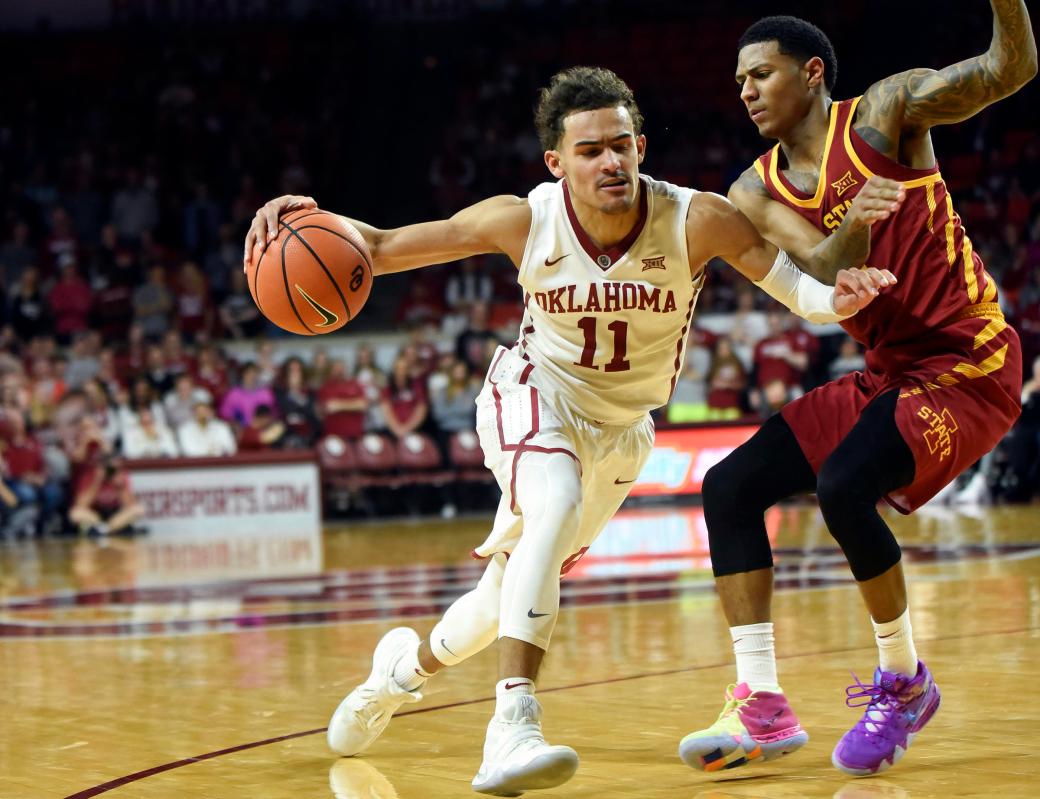
Unless you’ve been pulling a David Khan and willfully turning a blind eye to talent, you’re most likely aware that the 2018 NBA Draft class is Peter O’Toole-loaded. This class is laden with multiple legitimate candidates to be multiple time all-stars, and a few of those with the potential to ascend to All-NBA level and possibly compete for an MVP.
In this series, I’m going to be taking a look at the upper echelon of the class, and breaking down who I perceive to be the top pick and attempt to dial in what we’ll likely see from them in the future.
If you’ve followed high school basketball at all for the last couple years, you likely have been aware of the sniper-sighted Trae Young. He was consistently rated as the top PG in his class and played a year of college basketball at Oklahoma.
Right away, everyone’s minds raced to the last time we’d seen anything remotely similar to this: Steph Curry at Davidson. The long, ridiculous threes, the shifty how-did-he-even-make-that-angle happen, the appointment television each time he played, the baby-faced (and hair, let’s be honest) cool demeanor that he displayed while eviscerating people. Trae Young was very fun this past college basketball season, for a while.
But like any hero, there is a risk that your welcome be be overstayed, and your halo swapped for horns. Is Trae Young the next Jimmer Fredette or the next Chris Paul? Will he translate to the NBA?
TRULY WITHOUT RANGE
The most obvious place to start with Young is the shooting. A non-basketball fan could point to someone like Trae Young and say ‘wow, that guy can throw it in from a mile away,’ and he can. Trae’s comfortable range is truly astonishing. There were several, and I mean several instances in which he shot (and hit) 30+ foot threes during game action this year, often while being guarded.

Shooters have to be categorized, though, and that can greatly affect a guards ceiling. Lots of people (myself included, not to brag but you’d better get a damn hand up, son) can hit a three when they’re hit with a great pass and they have time to shoot a set shot. Young is exceptional at taking balanced shots from just about any angle – off the dribble to the left or right, off the catch to the left or right, stepping back, even when his normal shot pocket and shot motion are disrupted by some good defense.
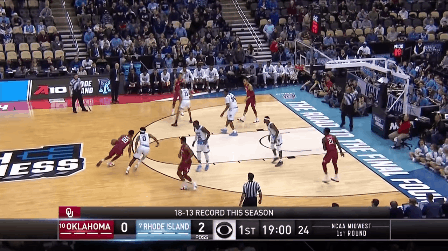
He practices this stuff, and there’s proof:

It could someday cause problems with the FAA, but I bet a lot of Young’s threes show up on flight radar, they arc so high (that joke was a swish, am I right?). He’s got a silky soft follow-through, and a snappy shot motion. His release point could stand to be a bit higher, though, because it’s currently right in front of his face.
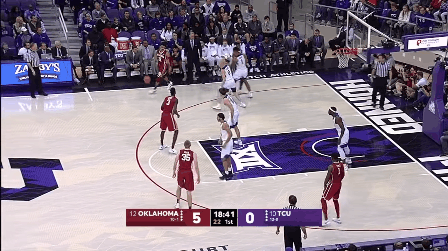
If Trae Young ends up on an athletic team in the NBA, he could put an absurd amount of pressure on the defense in transition, just with his ability to throw outlet passes and hit step-in threes. In this way he is very similar to Curry.
In rhythm, he’s a devastating long range shooter from the moment he crosses the mid-court. His range and his passing are probably his most translatable skills in the NBA. I think at the bare minimum Trae Young is a guy in your second unit that can come in and on a random night and blow up for 30 and five assists.
SWIVEL-HEADED DRIBBLIN’
Trae Young’s playmaking at Oklahoma was sensational at times, and there were nights where his uncheckable-ness led to (literally in one instance) dozens of easy buckets for his teammates.
He has a crisp, tight handle, and most impressive about Young is the pace at which he plays. Since he’s not an elite athlete, he forces guys with elite quickness to play at his speed. He’s also excellent at making a quick move at an opportune moment, changing speeds and freezing defenders because of how well his high basketball IQ allows him to survey the defense.
You can see that he loves to pick on big guys that don’t get back.
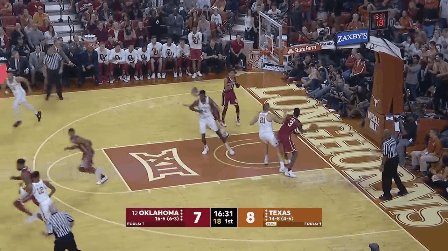
I would put Trae’s court vision in the upper tier of point guards his age, although I’m not sure I would him the stratosphere of the all-time ‘wish-I-could-play-with-that-dude’ guys, and there’s a particular reason why.
The jury is out on what type of playmaker Young will be with good teammates. We’ve seen him dominate the ball at the high school, AAU and college levels now. His single season usage rate was the highest at a power five school since the stat has been kept by Basketball-Reference. By the end of the season, it had become clear that the mystery and awe of Trae Young had turned into a bottlenecked offensive approach for OU, and the team struggled as a result. He’d been thoroughly scouted by conference opponents.
I have heard/read lots of commentary trashing Young’s teammates, and to be frank, I think that’s complete bullshit. They might not be the strongest supporting cast, but a top notch point guard elevates his teammates and finds ways to spread the offensive gravity on the floor.
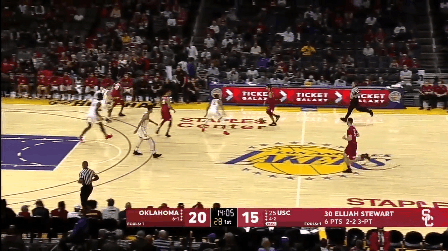
So what’s the adjustment? Clearly at that point you get the ball out of Young’s hands a bit and force teams to take some defensive pressure away from him, right?
Yeah, not really what happened at all.
Blame Lon Kruger, blame Young’s disposition as a player, but not much changed, and it seemed clear to me from watching several of Oklahoma’s games that the trust between Trae and his teammates began to do some wobblin’.
It’s important to note as well that a hefty percentage of Trae’s assists came on home run-type scenarios, which is also why he led the nation in assists. Let’s face it, if you are only touching the ball in a situation where a person is clearly hunting an assist or trapped with nowhere to go (a Kobe Pass, as I call it), your attributes as a player start to feel undervalued and misused. Maybe you stand on that next possession and feel less willing to backdoor cut.
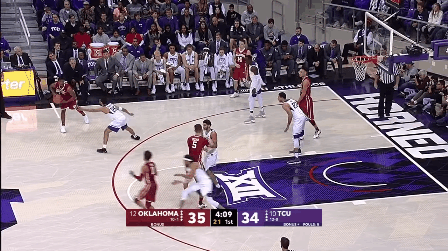
I can only imagine this is what happened with Oklahoma’s team. It’s also happened with guys that play or have played with Russell Westbrook. Maybe it’s something about the state of Oklahoma.
Without putting too much stock into his time at OU, you have to come away at least saying that Young is a very, very good outlet passer, and a guy that forces you to impede his vision in transition and in the halfcourt. He’s just got a great feel for the game in that sense.
DEFENSE IS OFFENSIVE
Trae basically has no defensive identity at this point. Oklahoma took a ‘we have a star that we have to protect’ approach to their defense this year, rarely having Trae guard ball handlers and tucking him in the corner. He’s a hang-back-and-contain defender that’s rarely looking to pressure a ball handler. Essentially he does his due diligence and that’s about it.
He’s quick enough and intelligent enough to develop better habits in his defensive footwork, but still in a tough position physically to defend the guard spot in the NBA. It’s important to remember as well that it’s difficult to adjust defensively at any level, much less two levels in a year’s time. Some of this could be easily alleviated by extra effort:

But some of this is because he’s at a disadvantage physically. I have a hard time not seeing him not get picked on in the pick and roll, because that’s just how the pro game operates: find the weak point and exploit. Imagine the first time Trae gets screened by Robin Lopez or Al Horford.

COMPCLOUD™️
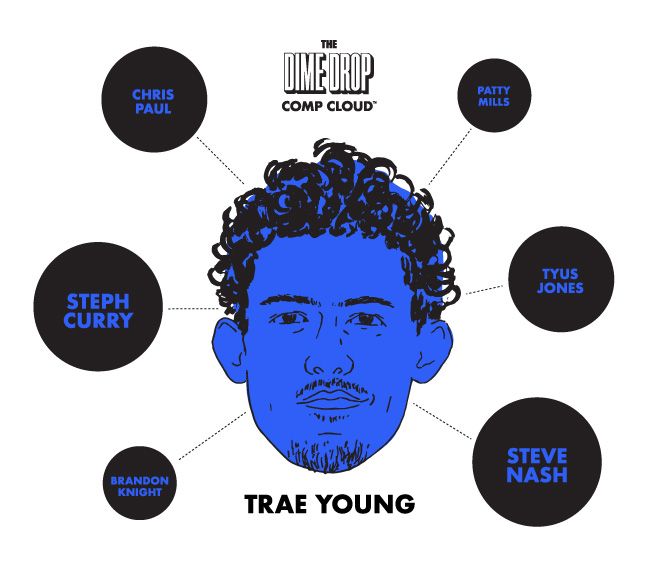
People love the Steph Curry comparison, and in the sense that Curry and Young both make incredibly difficult shots — yes. To me, Young has the ability to tap into something that Curry has mastered, and that’s taking the fear that people have of his jumper and letting that be a huge advantage for his teammates. One ball fake from either guy and the average defense is instantly in flux. Fear of a great shooter is a powerful thing.
Overall, Trae is a tricky person to pull a comparison for 1:1. Sure, his shooting is similar to Curry, but Curry was/is sneakily a pretty decent athlete, and at the same point in his development a much better finisher.
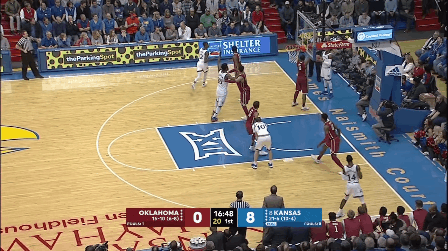
As a passer, there are glimpses of Nash, and as a ball dominant playmaker, I can see some personality traits that are similar to CP3.
A CLOUDY CRYSTAL BALL
Despite the worries about Trae’s size, it’s very likely that he will have a long stint in the NBA because of his extremely strong ball skills and the fact that physically it’s not like he’s depending on his athleticism to do his thing. It’s the same reason we see Chris Paul playing at a high level now, all these years later. 10-15 years from now I could easily see him being largely the same guy.
On a team with some explosive, long athletes that could hide some of Trae’s defensive shortcomings, I could see him being a very, very effective player. In the wrong situation, on a bad team that lacks shooters or rim protection, I could see Trae having a season of some exciting moments, but possibly more of what doomed his time at Oklahoma. Philadelphia and New York both are very intriguing possibilities because of their perimeter length, but he likely won’t slide that far. The chatter thus far has been that Orlando will happily snatch him up if given the chance.
If he really commits himself to being a run-the-show point guard that makes his teammates better, Trae could be a fantastic NBA player. If he stays a ball-dominant score-first point guard whose usage rate stays absurdly high, I could see his career being a shoulder shrug with some exciting nights where he’s hot.
Hopefully, as basketball fans, we’ll get to see the former instead of the latter.
Do These Four Things & You Can Beat Villanova
Other than being super handsome and possibly having access to a cloning machine that is set to “6’3” guard that can dribble, pass and shoot pretty,” Jay Wright is a great basketball coach. It more or less never fails: every single year they play a brand of basketball that’s difficult to deal with.
They’re skilled, they play together, they shoot it well, and so on and so forth.
Here are some puns:
In 2018, they do not stray from doing things the Wright Way. Wright on target. Wright where we wanna be. ‘Wright’ said Fred (Hoiberg?). Great coach, in his own Wright. Wright as rain. The kids are all Wright. Currently on the Wright side of history.
Cool, man.
Villanova can score the ****ing basketball. Offensively, they are in rarified air, in case you haven’t heard. Currently sitting at (according to Ken Pom) 127.6 in adjusted offensive efficiency for the season. Since this stat has been kept (2002), only one team has had a higher offensive rating for a season: 2015 Wisconsin. You remember them — Frank the Tank, Sam, Nigel Hayes, those dudes.
Their scoring is incredibly balanced in their top six players. All six guys average double figures (SIX!), and the two-headed snake at the forefront of that attack is Jalen Brunson (19.1 PPG) and Mikel Bridges (18.0 PPG). Both are physical, patient players with a wealth of experience. Both guys were also on the court a ton in Nova’s 2016 National Championship run.
So, let’s say, hypothetically, you wanted to beat Villanova. How would you do it?
Here are some important checkpoints if you want to tame a Wildcat dander allergy in March.
I. GET. BACK.
Nova’s offense is deadly because of how balanced it is and how fast it operates.
Getting back defensively is crucial against Villanova because of their offensive philosophy. Nova wants to make a post move, shoot a three or find a straight-line drive within the first moment of having the ball. Their sole intent is to catch you unprepared and to attack before the defense is set. They want you off balance and scrambling. They do this by eliminating any inkling of hesitation and shot faking you to death. Discomfort is the name of the game.
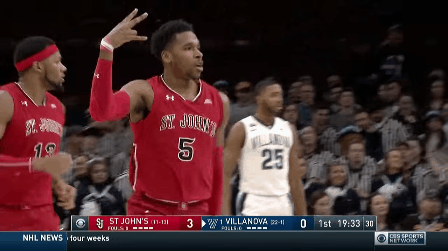
This can make their shot selection seem chaotic, but it’s all by design. Don’t confuse speed with freewheeling recklessness. Their speed is guided and methodical. If they suspect that you aren’t quick to get back into your defensive scheme, they will run their primary and secondary breaks even off of made baskets. Their whole unit, bigs included (really it’s usually just one, so, singular big, I guess) is extremely mobile.
Have to, have to, have to, have to get back and limit their transition break. Also important to remember that “transition” is different for a team like Villanova. Makes or misses, they can put the pressure on you.
II. Force them to guard the interior.
As we said before, Nova’s strength as an offensive team is a result of their extremely versatile top six players. The one caveat of playing so quickly and having such a sophisticated motion offense is that you’re typically playing with smaller players (unless you’re the Golden State Warriors). There isn’t a player over 6’9” on their roster, and they primarily depend on Omari Spellman (6’9” freshman) and Eric Paschall (6’6” junior) to carry the bulk of the load inside.
Rim protection is not a focus of Villanova’s defensive approach. They’d rather take charges, aggravate and pressure your primary ball handlers into making tough passes over multiple defenders, and get steals.
Don’t expect to pound it inside and take your sweet ass time backing down a smaller Villanova player – the extra pressure will come and it’ll come quickly, so the decision making there has to be crisp. You have to hope that foul trouble and offensive rebounding contribute to your case.
III. Keep the possession count low.
I know what you’re thinking: this doesn’t mean take the air out of the ball. If each team has 10 possessions or if each team has 10,000 (the D’Antoni wet dream) – Villanova is still more likely to score consistently per possession than you are, and subsequently to hit more threes. All of this goes back to pace, and you want to make sure that (unless you are Steve Kerr reading this and you’re somehow playing Villanova), you keep the pace from becoming an 85-100 point game, where your chances of winning decrease.
So how do you limit possessions? If your team is long enough (Duke is probably the best candidate at this point) you might be able to sit back and eliminate the worry of switching/not switching some of the trickier actions that the screeners do in Nova’s offense. Their roll and replace is particularly good:
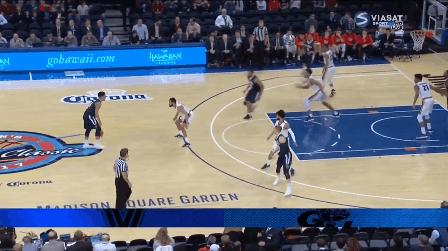
Obviously this leaves you susceptible to their otherworldly ability to shoot the three. Again, if you have the length to pressure and slow down the passing lanes when they perform one of their patented lightning fast ball reversals, you have to do it. Winning the rebounding battle, wisely using the shot clock, avoiding trouble areas on the floor where Nova loves to force turnovers – just a few ways you can keep from playing the style of ball that they would prefer.
IV. Avoid bad shots like the plague.

Don’t get in a manhood measurin’ contest
The temptation to play fast is a macho competition for most guards on planet earth, but that temptation has to be avoided at all costs.
No team has beaten Villanova this season without shooting the ball at least reasonably well. It’s cliché to say ‘hey pal, makes some shots.’ I’m aware. Every team in the universe is better when they make shots. In that way, basketball can be remarkably simple at times, when you’re retracing your steps and trying to figure out why you won or lost. Laying an egg from three and failing to at least hit some shots is the easiest way to give yourself a chance against such unrelenting offensive pressure.
So there you go! Also, you’d better hope they’re not hot from three! Byyyy-eeeeeeeee…
*Opens window*
*Pulls out a hidden hang glider*
*Disappears into the night*
WATCH: Breaking Down the Crafty EJ Montgomery
Hate reading? You’re in luck: I put the deep dive on EJ Montgomery in video form. Get some.
The Five Most Iconic Opposing Players in UK’s Tourney History
When Kentucky’s 2018 NCAA Tournament bracket was released on Sunday, it wasn’t necessarily a team but rather a player that had everyone concerned: DeAndre Ayton, the seven-foot behemoth and potential #1 pick in the NBA Draft.
I had this piece prepared in case that matchup took place, but unfortunately (for the purposes of simply wanting to see it), Buffalo beat the snot out of Arizona and created for Sean Miller one of those gaps on your résumé that you have to creatively explain away.
Let’s take a look at the most iconic opposing players Kentucky’s faced since 1990 (AKA since I have coherently followed basketball).
5. Kemba Walker, Connecticut

Everyone knows the Kemba story, because he’s taken the mantle of “a single guy could get hot and carry a team to a title” that you hear every person postulate about as they fill out their bracket. I guess that mantle used to belong to Danny Manning? It’s an uncommon event, however you want to slice it.
Kemba played all 40 minutes for UConn and did exactly what he’s known for: he created offense, and a lot of it. His line of 18 points, seven assists and 6 rebounds led a balanced attack that ultimately proved to be too much for Kentucky. And yes, there were plenty of crossover-crossover-stepback moments. It marked the first of two occasions where UConn (as a lower seed) knocked a Calipari/Kentucky team out of the Final Four.
Kemba’s gone on to have solid NBA career thus far, becoming Charlotte’s franchise player (although he’s probably one of the lesser franchise players in the NBA) and made his second NBA all-star team in 2018.
4. Rasheed Wallace & Jerry Stackhouse, North Carolina.
Going to lump these two guys together because their career trajectories were similar, and because it was in one game. In 1995 Kentucky had a phenomenally balanced team, anchored by juniors Tony Delk and Walter McCarty. They’d entered the tournament with Antoine Walker coming into his own, finally bursting on the scene as a freshman and winning the SEC Tournament MVP. The UNC win was a minor on-paper upset at the time, but the game itself was bizarre — an early (now legendary) scuffle between Andre Riddick and Wallace put a cloud over the game for Kentucky, and Carolina’s talent ultimately made a huge difference.
North Carolina is top heavy talent-wise, featuring Wallace and Stackhouse, who would both go on to become multiple-time all-stars. Stackhouse’s career came with a ton of hype and expectation, with lots of people throwing his name into the “Next Jordan” conversation, which would likely helped by the fact that he was a Tar Heel. It wasn’t an insane idea at the time, and for much of Stackhouse’s career, he was a dominant scorer. In 2000-01 he lead the NBA in points scored with 2,380, and he’s 100th on the all-time scoring list with 16,409 career points.
Wallace’s career averages are strong, but they hardly address the high water marks of his career. There were times where Sheed was one of the two or three best forwards in the game, and a top ten player in the NBA. From 2000 to 2005, he was a catalyst on several great NBA teams in Portland and Detroit. His effort in the 2004 finals against the Kobe/Shaq Lakers will likely be his legacy. That and the technical fouls.
3. Christian Laettner/Grant Hill, Duke

Laettner is here really only because of his amazing college career (two national titles, 1992 national player of the year) ranks as one of the best of all-time. For Hill, it’s the opposite. Although he was damn good in college as a devastating secondary option on a talented team, Hill’s longterm impact on the NBA as an interchangeable piece would be felt for quite some time. There was a time when Hill was entering the conversation for best player in the league not-named-Jordan. Check the tape, it’s true.
Hill was phenomenally versatile at 6’7”, and was more or less uncheckable from 1996 to 2000. Injuries kept us from seeing the full sample size of his prime, and he’s one of the big what-ifs of the NBA in that sense. He was far from a disappointment, though, and after basically getting cybernetic ankles and becoming more machine than man, he had a long and productive career as an upper echelon role player/contributor.
The Game: Look man, I’m not summing up this game. Piss off.
2. Tim Duncan, Wake Forest
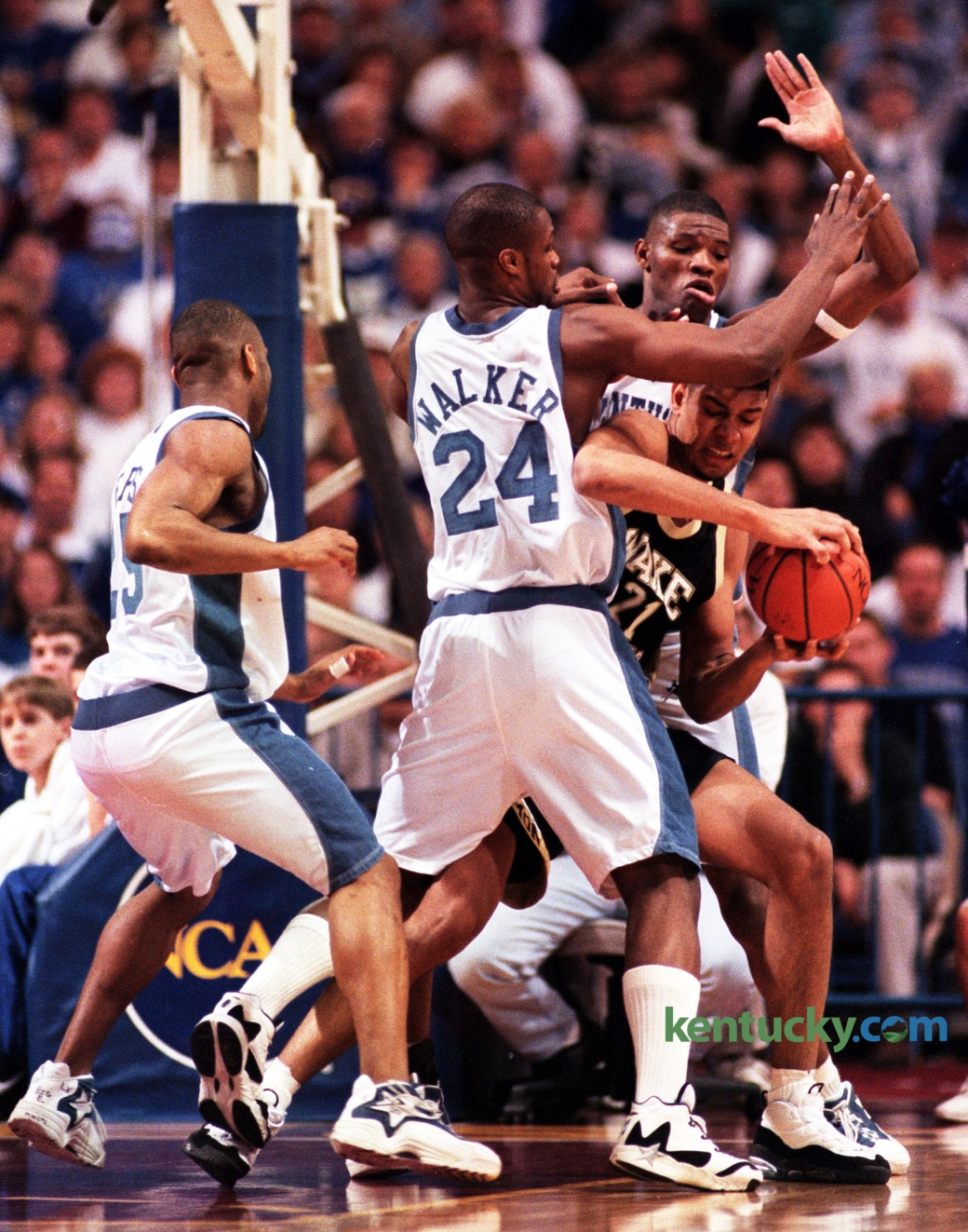
TIIIIIIMMAY! The Big Sorta-Fun-to-Watch Play! Quite possibly one of the best top 10 players ever to play in the NBA, and a guy who also set a ton of records in college basketball (some that stood for a while, but still ranked near the top). He’s quite possibly the last four-year #1 pick, and it’s always amazing to factor this in when you think about the length of his professional career. A 10-time first team all-NBA’er, a five-time NBA champion, the 1998 NBA Rookie of the Year, two-time NBA MVP and 8-time NBA All-Defensive First Team. The dude had some kind of career, and for an absurdly long time.
The Game: 1996. Rick Pitino is fairly teased these days. He’s done a lot to draw the criticism he’s gotten, but it’s hard to bully his ability to draw up a defensive game plan. Kentucky’s depth in the frontcourt absolutely harassed Duncan for the entire afternoon. Walter McCarty, Mark Pope, and Antoine Walker seldom let Duncan have an offensive thought, much less a move of any kind out of a post-up. Kentucky cruised to a 20-point win and eventually a national championship.
- Dwyane Wade, Marquette
Dwyane Wade is probably the third best shooting guard of all-time, behind two schlubby guys named Michael Jordan and Kobe Bryant. Their stories can be found with some digging. With four NBA titles, career averages of 22.6 PPG, 5.5 AST, and a PER of 24.0, it’s just not an argument: Wade is one of the five best players of the 2000s, and a top 50 player of all time. He’s also one of the best closers of his era.
The Game: Let’s be totally honest and call this game for what it was – legendary. 2003. This was a brutally unfortunate collision course for Kentucky. Their leader and best player, Keith Bogans, had badly sprained his ankle against a Devin Harris-led Wisconsin team just a few days prior. Marquette came out and delivered a full-blown, blow-the-doors-off, breaks-beaten-off-and-to-smitherines ass whipping. You could see from the tap that Marquette’s eff-you percentage index was soaring into unseen heights, and they jumped on Kentucky hard. The most dominant team of the Tubby Smith-era had roared to 27 wins in a row and went out with a whimper, denying Tubby another Final Four.
The Man: Let’s be totally honest and call game for what it was – legendary. Dwyane Wade is probably the third best shooting guard of all-time, behind two schlubby guys named Michael Jordan and Kobe Bryant. Their stories can be found with some digging. Wade is one of the best closers ever to play. With four NBA titles, career averages of 22.6 PPG, 5.5 AST, and a PER of 24.0, it’s just not an argument: Wade is one of the five best players of the 2000s, and a top 50 player of all time.
Honorable mention: Rodney Rogers, Mike Bibby, Bobby Jackson, Larry Hughes, Elton Brand, Shane Battier, Andre Miller, Mateen Cleaves, Andrew Bogut, Rudy Gay, Jared Sullinger, Royce White, Victor Oladipo, Frank Kaminsky/Sam Dekker.
WATCH: How Good is James Wiseman? (A Video Companion)
A little video companion for our piece about James Wiseman and his future.
How the Hell Do We Know What to Expect from Kentucky?
It’s hard to know what this Kentucky team is going to do in March.
It’s difficult to project the ceiling of an inexperienced (and highly talented) team like like this one. The lineup shifts and injuries have left a super young team — which are already prone to bouts of volatility, production wise — to be even more difficult to project.
It could be argued (and I would) that it’s only reasonable to assess the progression of this Kentucky team when it’s been equipped with Jarred Vanderbilt, whose rebounding impact has been as severe as as a bologna sandwich burp in a crowded elevator. Kentucky’s offensive/defensive identity has radically changed with him in the lineup.
As a complete roster, we’ve essentially seen 14 games, all in conference, to give us an idea of what this team will be going forward, and even then those games were subjected to a rapid-acclimation plan for Jarred Vanderbilt. Kentucky was 7-7 in those games, and I want to take a look at some of the trends that have occurred during that time.
ROCK THE MIC LIKE A VANDO
There’s a direct correlation between (albeit not causal) Kentucky’s best offensive lineup becoming acclimated and Kentucky also losing games.
With the team operating as it previous had, they were able to eek out wins against Georgia and LSU. Whether or not this motivated a false sense of security is unclear, but you can see that Vanderbilt’s minutes slowly increased during the most difficult portion of the schedule, against four of the more talented teams in the league: Missouri, Tennessee, Texas A&M and Auburn.
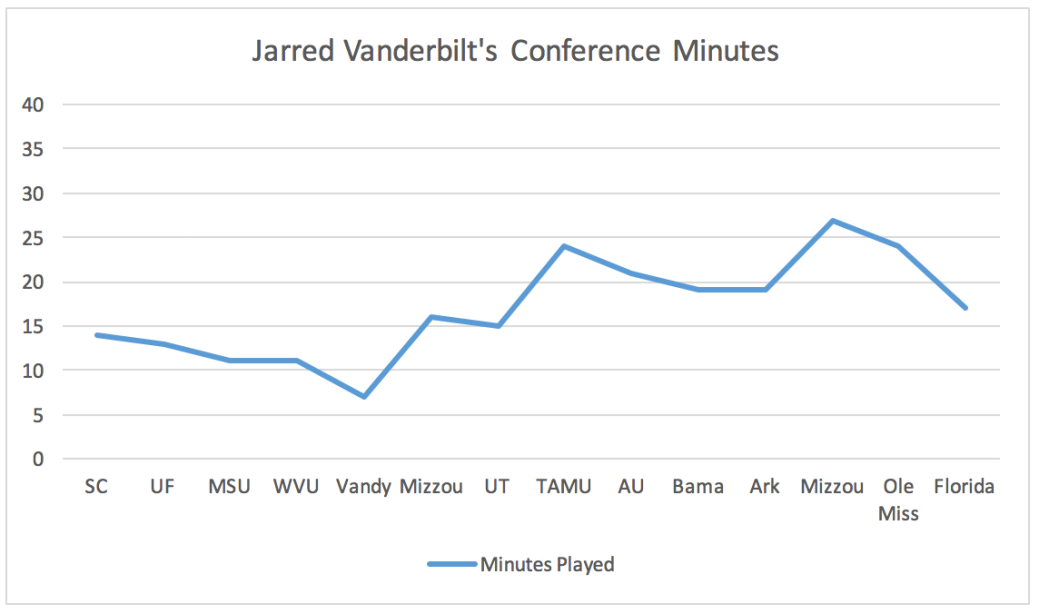
This caused a bit of an identity crisis for Kentucky during the middle portion of the conference schedule, and I think people tend to discount that. Let’s address that, shall we?
GOTSA WATER DEM PLANTS
This has been the story of the middle and back half of the conference schedule, for these kiddos. Defensively, this team has steadily improved over the course of the year, and there’s been a clear upswing in effort on that end of the floor. Offensively, they showed growth, but only during that increase in Vanderbilt’s minutes was it as a complete team.
There was a clear line of offensive identity that you could trace through the season, and it goes a bit like this:

So let’s talk about that usage.
In this sample size that we’ve all agreed on (WE’VE ALL AGREED ON IT), the usage numbers at Kentucky’s point of attack tell a story.
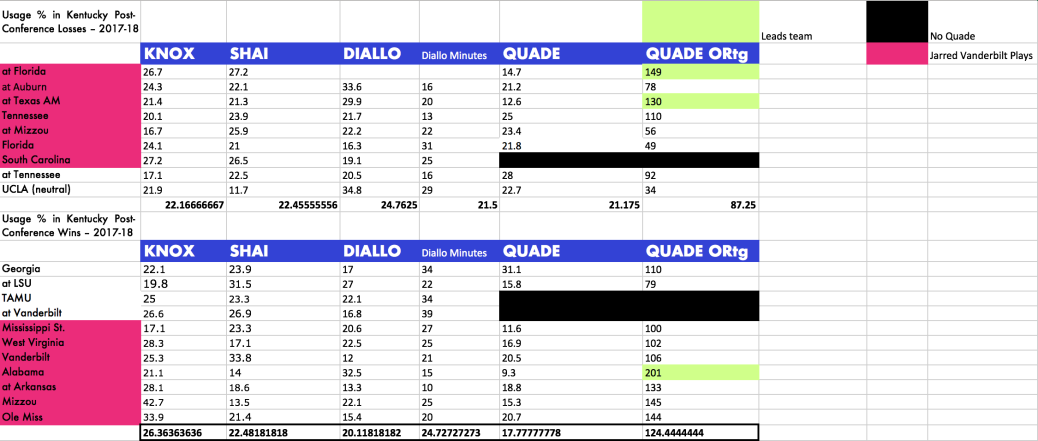
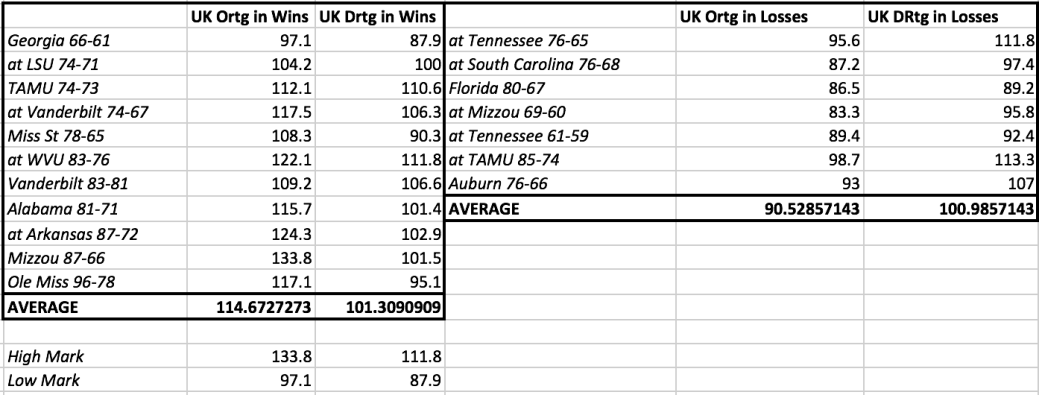
A few things jump out.
First of all, it’s clear that a deliberate focus on Knox-specific sets keep the team on a healthy pace. Kentucky’s offensive rating during that time was 114.67, with a high water mark of 133.8 against Missouri at home.
Knox’s usage rate in that particular game: 42.7.
Kentucky’s next two most impressive wins saw offensive ratings of 124.3 (Knox 28.1) against Arkansas and 122.1 against West Virginia (Knox 28.3).
KEEP. KNOX. INVOLVED.
The more this kid gets his number called, the better Kentucky plays. This is so painfully and abundantly clear. The stats here just prove what most casual basketball fans could observe in five minutes: oh you mean that 6’9″ guy with an insane wingspan that can score in basically every imaginable scenario should get more stuff ran for him?!
Secondly, encouragement for Kentucky’s ceiling: there are multiple instances of Quade Green having some of the lowest usage-to-highest-offensive-rating stats on the team. It likely opens the door to an increased role for him on offense, which is a potentially positive variable for Kentucky’s ceiling going forward. Big shot makers are absolutely crucial in March, and it’s possible that Quade is the strongest candidate to be that dude for Kentucky.
Lastly: better shots for Diallo. If I am Calipari’s staff, I’m sending Diallo to a tattoo artist to have ‘LAYUPS OR OPEN THREES’ tattooed on the inside of his eyelids. Off-balance midrange jumpers, contested threes and baseline floaters are just off the board at this point. They’re basically turnovers for Kentucky.
EXTINGUISH THE FLAME OF BLAME
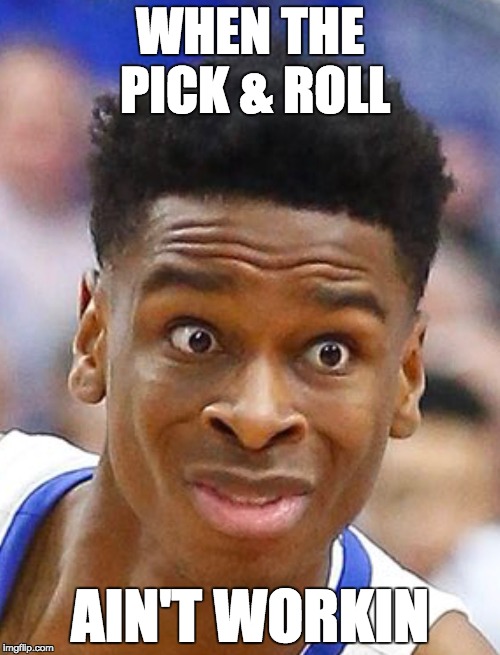
A common complaint among Kentucky fans down the stretch has been a plea for Quade Green to initiate the offense. While we saw a pretty clear statistical argument for his involvement, Quade’s initiation of the offense is not necessarily the recipe for a more efficient attack.
Yes, it’s true, Kentucky’s offense does have a tendency to breakdown when a majority of the sets are Shai Gilgeous-Alexander pick-and-rolls… but that doesn’t tell the whole story. It’s not the pick-and-rolls themselves, but the decisions that Shai makes after the screen action that dictate Kentucky’s offensive efficiency. When the ball stops being kicked to the wing and swung, they stagnate.
In the game against Ole Miss (a game Kentucky won by 18), Shai started the offense on 35 possessions where Quade was also on the floor. Eleven of those possessions were sets designed for Knox, and nine of them were pick-and-rolls.
When it’s winning time, the Shai high ball screen is a lethal weapon for Kentucky, so long as they don’t lean on it so hard that they fall down and eat shit.
TIME & MATURITY WILL TELL
A ten-loss team has not won a national championship in the last decade, but the losingest team in the last ten years to win a title (2014 Connecticut) beat the 2014 Kentucky squad that had 10 losses entering the tournament. A continued refinement of personality is not out of the question for these Cats. In fact, before the loss at Florida, it seemed likely.
That makes most of the top 25 Ken Pomeroy ratings difficult to interpret. Kentucky’s the most inexperienced team in the country, and when you figure in the injuries they’ve had (Quade and Vanderbilt), their inexperience is probably the most glaring of the Calipari era, and certainly the highest in the top 25 of the country.
Will they continue to improve? Will they flame out in the first weekend of the tournament?
You tell me. But I’d definitely have a difficult time betting against them.
____________________
Wanna contact the Dime Drop? Drop us one: dimedrop.mailbag@gmail.com.
Be sure to hit up the podcast: https://soundcloud.com/thedimedrop
Twitter: @jkylemann
WATCH: Wheeler vs. Newton (EJ Montgomery, Ashton Hagans)
EJ Montgomery’s (#6 in 2018) Wheeler Wildcats squad took on Ashton Hagans (#1 PG in 2019) and Newton Rams last night in the Georgia state playoffs. This is a great extended look at the two teams. Hagan’s Rams pulled away 87-81.
Hagans is a lightning quick point guard that recently reclassified to the class of 2018. He’s got great pace, an extensive layup package and has the tools to be an excellent perimeter defender in college and beyond. We’ll likely take a closer look at his game very soon.
Montgomery, whom we profiled extensively this week, is being heavily recruited by Kentucky, Duke, North Carolina, and Georgetown, among others. He’s a rare combination of silky stretch four offensive capabilities and exceptional court vision.